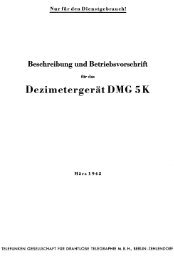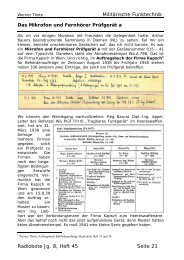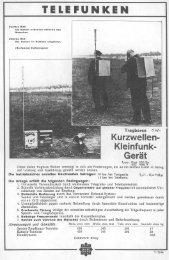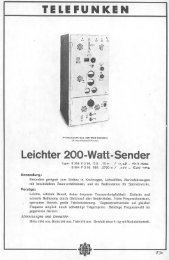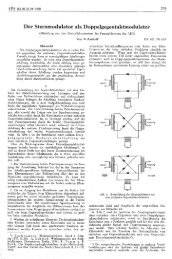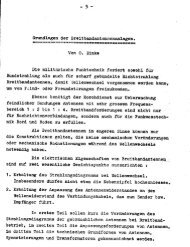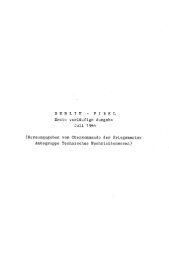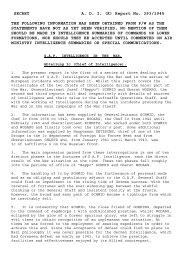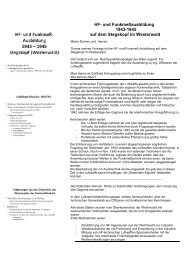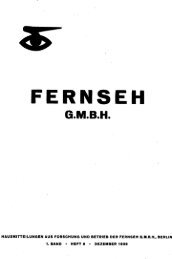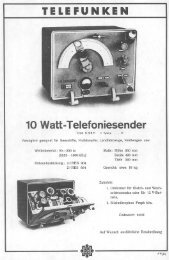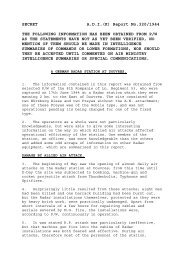SECRET A. D. I. (K) Report No. 357/1945. THE ... - Cdvandt.org
SECRET A. D. I. (K) Report No. 357/1945. THE ... - Cdvandt.org
SECRET A. D. I. (K) Report No. 357/1945. THE ... - Cdvandt.org
You also want an ePaper? Increase the reach of your titles
YUMPU automatically turns print PDFs into web optimized ePapers that Google loves.
Baldur - Truhe<br />
82. It was planned to experiment on a combination of Baldur and Truhe (Gee) for use by<br />
bombers. The intention was to use a hyperbolic grid line of Truhe for the target approach. This<br />
could be pre-set, and the pilot could fly along it by keeping the blip centralised, and could<br />
ascertain his exact position along the line by measuring his distance from a Baldur beacon. This<br />
system was considered simpler particularly for a single-seater aircraft, than the method of using<br />
two hyperbolic grid lines or two distances from Baldur beacons. The first experimental sets<br />
were to be ready in the autumn of this year.<br />
Baldur - Bernhardine<br />
83. A further project was a combination of Baldur and Bernhardine to give simultaneous<br />
bearing and range. The range indication was to be obtained by the pilot pressing a knob when<br />
the range would appear in kilometres on a dial. This system was suggested for use by both day<br />
fighters and bombers.<br />
GROUND CONTROL SYSTEMS,<br />
Benito.<br />
84. The Benito system of control using FuGe 16, known to the Germans as "Y", is too well<br />
known to warrant description. The following paragraphs deal with recent developments.<br />
85. When operating the bomber Benito procedure with the narrow beam. (0.3°) essential for<br />
azimuth accuracy, it was easy for the bomber pilot to get on to one of the side lobes in error<br />
since these were only about 3° from the main beam.<br />
86. In order to minimise the possibility of mistake and to relieve the pilot of the strain of flying<br />
on a beam, an automatic device, the FuGe 28a, was in use which was the improved and final<br />
form of the old Y-Gerät of 1941. Documents dated about June 1944 show that it was used in<br />
conjunction with FuGe 17, but P/W thought that it had been modified for use with FuGe 16ZY<br />
as well.<br />
87. The procedure was that the bomber pilot flew on instructions conveyed over the FuGe 17<br />
until it had been established by ground D/F stations that he was on the true beam, when the<br />
code word "Bako" would be given whereupon the pilot would switch on the FuGe 28a which<br />
took over control of the automatic pilot and kept him on the beam.<br />
88. P/W gave the accuracy of range measurement with the Bomber Benito procedure as only<br />
± 1 km. at maximum range.<br />
Egon.<br />
89. The original Egon procedure which involved the use of two Freyas, the one for rough<br />
positioning and the other for fine positioning - later became known as "Egon Einstand" (One<br />
location) to differentiate from an improved system termed “Egon Zweistand”<br />
90. Egon Zweistand was evolved to offset the inaccuracies in azimuth D/F, and cash in on the<br />
range accuracy of radar. With Zweistand a third Freya was introduced, placed some



